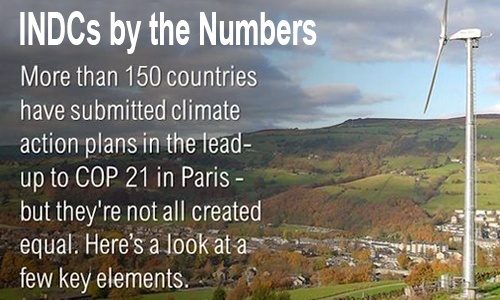


According to the report, which analyzes the clean energy plans of eight of the top 10 carbon emitters in the world, the Paris 2015 conference could help double the current market in the next 15 years.
National Climate Plans, by the numbers #INDCs https://t.co/6idKVVkYc1 #COP21 #Paris2015 pic.twitter.com/s9Urhf9SIN
— World Resources Inst (@WorldResources) October 30, 2015
“These new renewable energy targets send strong signals to energy markets and investment circles,” said Jennifer Morgan, global director of the Climate Program, at World Resources Institute.
Assuming these proposed clean energy plans are achieved, total annual renewable electricity generation will increase by nearly four times between now and 2030. This increase is equivalent to all of India’s current energy demand.
Here are some key highlights:
- China will increase the share of non-fossil fuel in primary energy consumption to around 20 percent by 2030;
- European Union will achieve at least a 27 percent share of renewable energy consumption by 2030;
- U.S. will increase the U.S. share of renewables—beyond hydropower—in the electricity generation mix to 20 percent by 2030.
The report also analyzed the current climate plans submitted by all the countries to the UNFCCC, the so-called INDCs. INDCs (intended nationally determined contributions) have been submitted by more than 150 countries and are expected to provide the fundamental plans for a global deal on climate change next month.

Out of the 127 INDCs submitted, 80 percent of them mentioned clean energy: 67 INDCs (53 percent) indicated clean energy targets and 35 INDCs (27 percent) committed to put forward clean energy actions.
This WRI report preceded the release of IEA‘s “World Energy Outlook 2015,” which gives approximately similar projections but with longer targets: Renewables-based generation reaches 50 percent in the EU by 2040, around 30 percent in China and Japan and above 25 percent in the U.S. and India.
“World leaders meeting in Paris must set a clear direction for the accelerated transformation of the global energy sector.” Fatih Birol, executive director, IEA.
Unfortunately, according to the IEA these INDCs and current renewables projections for emissions trajectory implies a long-term temperature increase of 2.7C by 2100. Therefore, more must be done to help all the countries accelerate, grow and implement this massive clean energy transition.
YOU MIGHT ALSO LIKE
Corporate and Financial World Are Finally Ready to Take Climate Action
Renewables to Overtake Coal as World’s Largest Power Source, Says IEA
Climate Change Poised to Push 100 Million Into ‘Extreme Poverty’ by 2030
UN Report Measures Significant Progress Ahead of Paris Climate Talks

 233k
233k  41k
41k  Subscribe
Subscribe 
